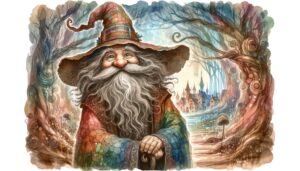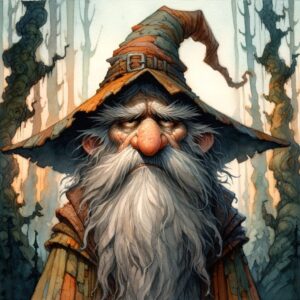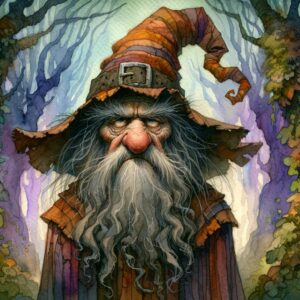Table of Contents
In the enchanting realm of Philippine folklore, a fascinating and diminutive creature known as the Duwende has captured the imagination of generations. These mystical beings, often described as mischievous, elusive, and protective, have etched their presence into the rich tapestry of Filipino mythology. Let us embark on a journey through the intricate world of the Duwende, a journey that will take us deep into their origins, family ties, appearance, abilities, symbols that represent them, and the myths and stories that surround them.
Origins and Family

The word “Duwende” itself stems from the Spanish term “duende,” which translates to “elf” or “goblin.” However, despite the linguistic similarity, Duwende are distinct creatures with unique characteristics deeply rooted in Filipino culture. They are believed to be the offspring of Anitun Tabu, the goddess of wind, and Agtayab, the god of forests and mountains, making them intrinsic to the natural world.
Duwende are often divided into various subcategories based on their elemental affiliations. Some are associated with the earth and soil, while others are connected to fire, water, or even the wind. This diverse family of creatures showcases the deep reverence that Filipinos have for the elements of nature and their role in daily life.
Appearance
Duwende come in a range of appearances, but they are typically small, standing at only a few feet tall. They have distinct features such as sharp and pointed ears, mischievous eyes that twinkle like stars, and wrinkled, weathered skin. Their clothing mirrors the earthy tones of the forest, helping them blend seamlessly into their natural surroundings.
One notable feature of Duwende is their tendency to wear traditional Filipino attire, often in the style of the pre-colonial period. These garments, adorned with intricate patterns and vibrant colors, further emphasize their connection to Filipino culture and history.
Abilities

Despite their diminutive size, Duwende possess a range of supernatural abilities that make them formidable and intriguing beings. Among their many talents, the following stand out:
In addition to shape-shifting, Duwende possess the remarkable ability to change their appearance, allowing them to move freely and unnoticed among humans. Consequently, this shape-shifting power enables them to protect their forest homes and interact with the mortal realm discreetly.
Moreover, Duwende can vanish and reappear at will, making them elusive and challenging to capture. This skill ensures their safety and allows them to carry out their protective duties effectively.
Furthermore, they can render themselves invisible to human eyes, adding an element of mystery to their presence. This power is often used to observe and safeguard the natural world without human interference.
Their most significant ability lies in their role as environment guardians. Duwende fiercely protect their forest habitats, ensuring nature’s balance while rewarding respect and punishing harm.
Symbology
Symbols play a vital role in representing the Duwende in Filipino culture. These symbols are not only visual representations but also carry deep cultural and spiritual significance:
Anthills: Duwende are believed to reside in anthills, which are considered sacred in Filipino culture. These small mounds of earth symbolize the connection between the Duwende and the earth itself.
Tribal Art: Traditional Filipino tribal art often includes depictions of Duwende, emphasizing their role as guardians of the land and nature.
Natural Elements: Duwende closely associate with earth’s elements, like trees, rocks, and rivers, symbolizing their presence and influence.
Traditional Attire: The clothing worn by Duwende is a powerful symbol of their connection to Filipino heritage and their status as protectors of traditional ways of life.
Myths and Stories

The Duwende have been central characters in countless Filipino myths and stories, contributing to the rich oral tradition of the Philippines. These tales often revolve around their interactions with humans and their role as both tricksters and protectors of the natural world.
One famous story tells of a farmer who built his house on a mound of earth, unknowingly disturbing a Duwende dwelling. The Duwende responded by playing pranks on the farmer, moving his belongings, and causing minor chaos. However, once the farmer offered a small plate of food and asked for forgiveness, the Duwende became his helpful companion, ensuring his crops thrived and his family prospered.
Another legend speaks of a fisherman who caught a Duwende in his net while fishing. The creature begged for his release and promised to grant him three wishes in return. The fisherman agreed, and the Duwende fulfilled his wishes, making him wealthy. Yet, the fisherman’s newfound wealth did not bring him happiness, and he longed for a simple life by the sea. He released the Duwende, who, true to his word, restored the fisherman to his former life of contentment.
These stories reflect the complex relationship between humans and the Duwende, highlighting their dual nature as both playful tricksters and benevolent protectors of the earth. They also emphasize the importance of respect for nature and the consequences of disrupting the balance of the natural world.
Cultural Impact
Furthermore, the Duwende continue to hold a significant place in contemporary Filipino culture. They serve as a reminder of the deep connection between the Filipino people and their natural environment. Additionally, their presence in folklore reinforces the importance of environmental conservation and the need to protect the rich biodiversity of the Philippines.
In literature and art, the Duwende are a popular subject. Filipino authors and artists often draw inspiration from these mythical creatures to explore themes of tradition, identity, and the enduring link between humanity and the environment. The Duwende’s role as both protectors and tricksters adds depth and complexity to these artistic representations.
Furthermore, the Duwende have made their way into popular culture, appearing in films, television shows, and even video games. They continue to captivate audiences worldwide, bridging the gap between ancient folklore and modern storytelling.
Thematic Exploration
The Duwende embody several compelling themes that resonate with people across cultures and generations:
Nature’s Guardians: The Duwende represent the idea that nature is not just a resource but a living entity deserving of respect and protection. They remind us of our responsibility to safeguard the environment and maintain harmony with the natural world.
Balance and Harmony: The Duwende’s role in maintaining the balance of nature reflects the universal theme of equilibrium in life. Their stories encourage us to find equilibrium in our own lives and communities.
Cultural Identity: Through their traditional attire and connection to Filipino heritage, the Duwende highlight the importance of preserving cultural identity in a rapidly changing world.
Dual Nature of Humanity: Just as the Duwende can be both mischievous and benevolent, humans too possess dualities. These mythical beings serve as a mirror to human complexities and challenge us to find the balance between our own light and shadow.
In Conclusion
The Duwende are not merely mythical creatures but profound symbols that transcend time and culture. Their origins in Filipino folklore, connection to the elements, and role as guardians and tricksters make them a fascinating subject of exploration. Through their stories and symbolism, the Duwende inspire us to protect our environment, embrace our cultural heritage, and seek balance in our lives.
As we delve into the enchanting world of the Duwende, we discover a timeless message: the importance of living in harmony with nature and embracing the richness of our cultural roots. These diminutive beings have left an indelible mark on Filipino culture, reminding us of the enduring bond between humanity and the earth. So, let us continue to celebrate and honor the Duwende, the guardians of the Earth’s secrets, and carry their wisdom forward for generations to come.
FAQ
What do Duwende look like?
They are small, with pointed ears and weathered skin, often wearing traditional Filipino attire.
Where do Duwende live?
They inhabit forests, mountains, and nature-related places in the Philippines.
What are their abilities?
Duwende can shape-shift, teleport, turn invisible, and act as guardians of the environment.
How do they interact with humans?
They can be playful tricksters or helpful protectors, depending on how humans treat them.
What symbols represent Duwende?
Anthills, tribal art, traditional attire, and natural elements symbolize their presence.
What is the cultural significance of Duwende?
They symbolize the Filipino connection to nature, culture, and the importance of environmental conservation.
Are Duwende still part of modern Filipino culture?
Yes, they continue to inspire literature, art, and popular culture in the Philippines.




